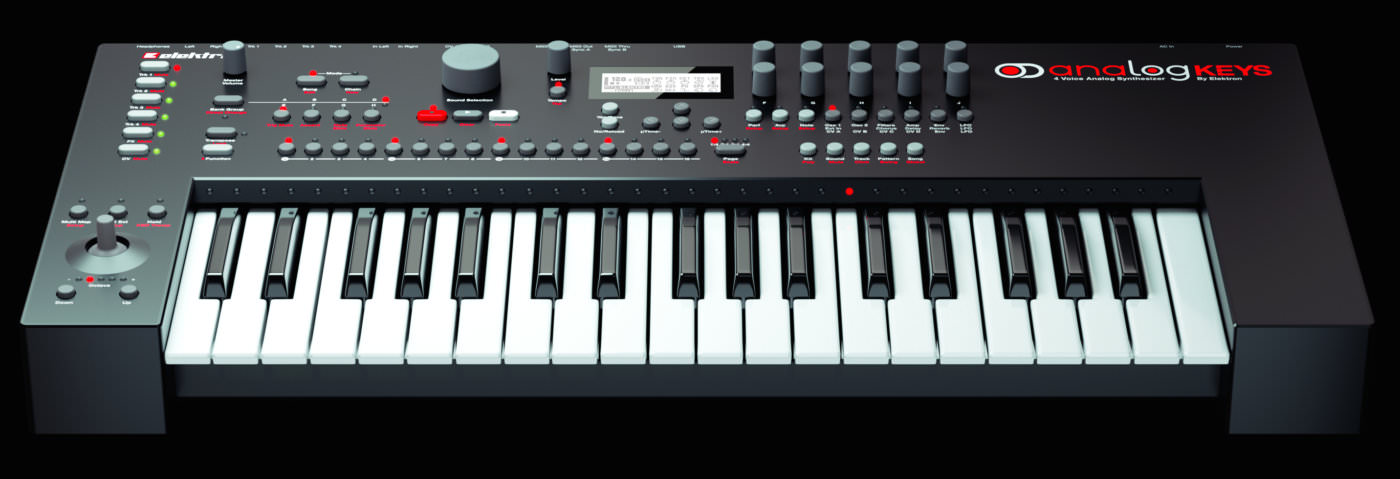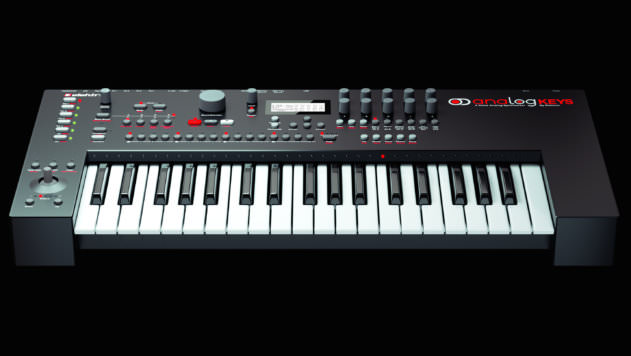Elektron’s product range has expanded dramatically over the last few years. Look back to 2011 and the Swedish company’s offering was boutique, mainly revolving around the Machinedrum series. Since then, they’ve expanded into new areas at an incredible rate, first with the Octatrack sampler/sequencer and then with last year’s Analog Four synth module. In a couple of months the range will expand further with the introduction of the new Analog Rytm drum machine, but for now the focus is on the Analog Keys, a fairly self-explanatory riff on the Analog Four.
Spec
Fundamentally, the Analog Keys is an Analog Four with a keyboard grafted on. There’s a little more to it than that, of course, but the easiest way to understand what the Keys has to offer is to look back at the Four.
Like its little sibling, the Analog Keys is a four-voice analogue synth with built-in sequencers and effects. The synth architecture is a standard subtractive approach with a comprehensive range of modulation options: in summary, two oscillators per voice, each with variable waveshaping and sub-oscillators; a 4-pole low-pass filter and a 2-pole multi-mode filter; overdrive and filter feedback; a noise source; a total of five LFOs and eight envelope generators.
Elektron’s designers have done a clever job of keeping the signal path analogue where it matters but also using digital modulation sources and effects where they offer advantages. Following the DCOs with their built-in analogue wave shapers, the filters, overdrive circuits and VCAs are analogue. The noise sources, LFOs and envelope generators are all digital. The entire digital effect section is wired in parallel, which means the dry signal remains untouched and the wet signal can be mixed back in to taste.
Elektron’s designers have done a clever job of keeping the signal path analogue where it matters
In use
It’s hard to pretend the Analog Keys is an intuitive synth. The extensive programming options combine with the screen-based editing system to create a keyboard which takes a little work to get to grips with.
Much like the Octatrack, this is a unit which demands that you learn how it works before you get started. Pulling it out of its box, I was impressed by the build quality and vaguely retro design (am I the only one who’s reminded of functional charcoal-grey classics like the Korg M1 and E-mu Emax?), but my initial attempts to dig into the editing system were clumsy at best without referring to the instructions.
There’s a 20-page Getting Started manual in the box, but I’d recommend downloading the full 122-page PDF reference manual from the Elektron site before going any further.
As for the sound? Every great analogue synth has a character, but the Analog Keys keeps its personality under wraps at first. The extensive list of presets includes a little bit of everything, leaving you guessing what the definitive sound of the synth might be. You’ll find a fairly convincing French horn patch alongside Minimoog-style bass, subtle pads and 303-style acid patches; it’s immediately apparent that the Analog Keys is incredibly versatile, but once you explore further and begin to tweak the parameters a certain character begins to appear.
The synth architecture here is fundamentally modern – clean, clear and up-front – but easily capable of being pushed into the more organic, fuzzy territory associated with vintage synths. That distinction is subtle but important: the Analog Keys can easily recreate a lot of vintage analogue sounds, but it can do a lot more besides. This is definitely a modern synth. As such, it should be considered alongside the likes of DSI Prophets rather than Roland Jupiters.
Every great analogue synth has a character, but the Analog Keys keeps its personality under wraps at first
Elektron tells us that the engineering team has “worked hard to make the low frequency capabilities of the Analog Four and Analog Keys stellar”. The version 1.1 OS update introduces a resonance boost feature (which also applies to the Analog Four), but there’s also a small difference in the hardware itself. According to Elektron this involved “reworking the ladder filter, ensuring it can deliver subsonic frequencies”.
We don’t have an Analog Four on hand to compare them side by side, but the bass which can be coaxed from the Analog Keys is undoubtedly impressive. Whether it’s down to that low-pass filter redesign or not, the Analog Keys has a seriously weighty sound if that’s what you’re looking for. But, more importantly, it can also do a lot more than just bass. This is a true flagship synth which is versatile enough to deliver any type of sound you can name.
Sequencing
The sequencing capabilities of the Analog Four have been well documented at this point, so we won’t go into too much detail here, but the same feature set has been ported across from the module to the keyboard.
The combination of keyboard and step sequencer is relatively unusual these days but it works well in this case whichever way you approach it: a module which can synchronise a part or two with a MIDI clock signal while you play over the top; or a workstation which can be used to sequence four independent synth tracks plus effects, CV outs and all of the parameter lock functions for which Elektron devices are regularly praised. It’s a seriously flexible approach which should suit studio work just as well as it can be applied to live performance.


10.05 AM
Interesting Read .. any sound examples?
10.14 AM
Hi Angie. We don’t create audio demos for all of our reviews but in addition to the Elektron demos above there are some really excellent user demos of the Analog Keys and Analog Four (which sounds virtually identical) on YouTube and SoundCloud.
02.53 PM
I’ll say that after having my A4 for about a year now, a keyboard would be a great companion, the tiny keys on the original don’t exactly lend themselves well to spontaneous performance.
12.48 PM
Some Sound examples and free patches for your A4 or AK https://soundcloud.com/synthausen/sets/free-analog-four-patches